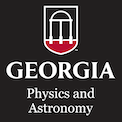If the skies are clear, we will be able to see various constellations and will use the telescopes to look at interesting stars, such as Albireo, a set of 2 stars in the constellation of Cygnus. If the skies are cloudy, then Dr. Scott Shaw will give a talk on Dark Matter in the main lecture hall (Room 202 in the Physics Building).
Events Calendar View
-
Observatory Open House
Sep 23, 2011
Observatory Open House
-
CSP Lunch Seminar
Sep 27, 2011
Thermodynamics and structural transformation of lattice HP proteins adsorption: A Wang-Landau study
-
Departmental Colloquium
Sep 29, 2011
Photoprotection in biomolecules following UV absorption

Guest: Dr. Vasilios Stavros, University of Warwick, Department of Chemistry
Thursday, September 29, 2011 4:00 pm - 5:00 pm
Location:Through evolution, molecular function has been finely tuned, such that even the most complex of chemical processes occurring in humans takes place with exceptional efficiency. To understand why nature has chosen a particular set of molecular building blocks, a surge in gas-phase experiments has recently targeted the resistance to photochemical damage (photoprotection) of key DNA bases, amino acids and their corresponding subunits. This has, in turn, provided insight into their properties. The talk gives an overview of our group's efforts to unravel some of the photoprotection mechanisms of heteroaromatic biomolecules following UV absorption using time-resolved spectroscopy. It also discusses our group's latest endeavors at extending these measurements to the condensed phase.
-
NanoSEC Seminar
Sep 30, 2011
Curvature-Induced Dielectrophoresis for Particle and Cell Manipulations in Microfluidic Devices
Dielectrophoresis (DEP) is a powerful tool that has been widely used to manipulate (e.g., focus, trap, concentrate, and sort) particles and cells in microfluidic devices. Traditional electrode-based DEP (eDEP) arises from the non-uniform high-frequency AC electric field between pairs of electrodes that are fabricated within a microchannel. This method suffers from the problems of fabrication complexity and electrode fouling etc. Such problems are significantly mitigated in the so-called insulator-based DEP (iDEP) devices, where both AC and DC electric fields can be applied through the electrodes that are positioned virtually outside a microchannel. However, in-channel insulating obstacles such as hurdles, posts, and ridges are required to create the electric field gradients. The locally amplified electric field around these micro-obstacles may cause adverse effects on both the sample and the device due to potential Joule heating and particle clogging issues. Our group has recently developed a new method that exploits the curvature of insulating walls for a diverse electrical control of particle and cell motions in microfluidic devices. Due to the variation in path length for electric current, the electric field becomes inherently non-uniform within a microchannel corner. Thus induced DEP can generate both a crossstream and a counter-stream particle motion, which are second-order function of the electric field and are superimposed to the linear electrokinetic motion for flexible particle manipulations. In this talk I will present our recent results on the dielectrophoretic focusing, trapping, concentration, and separation of particles and cells in curved microchannels and microfluidic reservoirs with applications to lab-on-a-chip systems.
-
CSP Lunch Seminar
Oct 4, 2011
Thermodynamics and structural transformations of lattice HP proteins adsorption: A Wang-Landau study (Part II)
-
Departmental Colloquium
Oct 6, 2011
M Dwarf Variability: A Barrier to Detecting Rocky Planets?

Guest: Dr. Angelle Tanner, Mississippi State University, Department of Physics and Astronomy
Thursday, October 6, 2011 4:00 pm - 5:00 pm
Location: Auditorium, Physics 202We are on the verge of potentially the most significant scientific discovery of the past century. The detection of a habitable planet around a star in our solar neighborhood. Currently, infrared radial velocity surveys with precisions of 5-10 m/s are marginally sensitive to Earth-mass planets in the habitable zone of late-M dwarfs (RV signatures of > 5 m/s for an Earth around an M9 star).Indeed, M dwarfs are the primary focus of multiple up-coming infrared RV observing programs with new instruments (ESPRESSO on the VLT) and instrument upgrades (NIRSPEC on Keck and CSHELL on the IRTF). However, if our goal is to detect Earth-mass planets in the habitable zone of a solar-type star (an RV signature of 0.1 m/s for a solar-type star), then it will be advantageous for us to determine the intrinsic jitter inherent to each star in order to better design these observationally intensive observing programs. Optical RV planet search programs have shown that, while in many cases stars with indicators of high photospheric activity also have large RV jitter and there are hints that such activity is correlated with stellar spectral type, the known activity indicators do not always predict the degree of jitter for every star. Here we summarize the need for observing programs to focus on the jitter properties of the nearest stars M dwarfs which are prone to large starspot populations and flares. Future ground-based, milli-mag photometry and star spot modeling as well as the statistical results from the Kepler, MOST and Corot missions will provide starspot rotation periods (a few days to weeks) which are directly related to the RV jitter. The results of this study will be used to infer limits to Earth-mass planet detections around solar-type stars an issue which has not been thoroughly addressed observationally despite the critical limit of a precision of 0.1 m/s needed to detect them in the habitable zone.
Page 24 of 121, showing 6 records out of 723 total, starting on record 139, ending on 144

